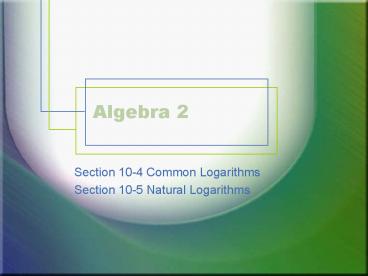Algebra 2 - PowerPoint PPT Presentation
1 / 22
Title:
Algebra 2
Description:
Section 10-4 Common Logarithms Section 10-5 Natural Logarithms What You'll Learn Why It's Important To identify the characteristic and the mantissa of a logarithm To ... – PowerPoint PPT presentation
Number of Views:33
Avg rating:3.0/5.0
Title: Algebra 2
1
Algebra 2
- Section 10-4 Common Logarithms
- Section 10-5 Natural Logarithms
2
What You'll LearnWhy It's Important
- To identify the characteristic and the mantissa
of a logarithm - To find common logarithms and antilogarithms
- To find natural logarithms of numbers
- You can use common logarithms to solve problems
involving astronomy and acoustics. - You can use natural logarithms to solve problems
involving sales and physics
3
Common Logarithms
- One of the more useful logarithms is base 10,
because our number system is base10 - Base 10 logarithms are called common logarithms
- These are usually written without subscript 10,
- so log10x is written as log x
4
What is the relationship?
- Find the logarithms of 5.94, 59.4, 594 and 5940
- What do you notice?
5
What is the relationship?
- Find the logarithms of 5.94, 59.4, 594 and 5940
- What do you notice?
- The decimal parts are the same, the integer parts
are different
6
Mantissa Characteristic
- The decimal part is called the mantissa
- The logarithm of a number between 1 and 10
- The integer part is called the characteristic
- The integer used to express a base 10 logarithm
as the sum of an integer and a positive decimal - The characteristic is the exponent of 10 when the
original number is expressed in scientific
notation.
7
Example 1
- Use a scientific or graphing calculator to find
the logarithm for each number rounded to four
decimal places. Then state the mantissa and
characteristic. - A. log 120
- B. log 0.12
Reminder of what a log really is
8
Solution Example 1A
- Use a scientific or graphing calculator to find
the logarithm for each number rounded to four
decimal places. Then state the mantissa and
characteristic. - A. log 120
- You can set your calculator to round to 4 decimal
places
The characteristic is the exponent of 10 when the
original number is expressed in scientific
notation.
2.0792
Mantissa
.0792
Characteristic
120 1.20 x 102
2
9
Solution Example 1B
- Use a scientific or graphing calculator to find
the logarithm for each number rounded to four
decimal places. Then state the mantissa and
characteristic. - B. log 0.12
- The mantissa is usually expressed as a positive
number. To avoid negative mantissas, we rewrite
the negative mantissa as the difference of a
positive number and an integer, usually 10
-0.9208
Mantissa
.0792
Characteristic
-1
0.12 1.2 x 10-1
10
Example 2
- Use a calculator to find the logarithm for 0.0038
rounded to four decimal places. Then state the
mantissa and characteristic.
11
Solution Example 2
- Use a calculator to find the logarithm for 0.0038
rounded to four decimal places. Then state the
mantissa and characteristic.
Log 0.0038 -2.4202
Mantissa
0.5798
Characteristic
-3
0.0038 3.8 x 10-3
12
Antilogarithm
- Sometimes an application of logarithms requires
that you use the inverse of logarithms,
exponentiation. - When you are given the logarithm of a number and
asked to find the number, you are finding the
antilogarithm. - That is, if log x a, then x antilog a
13
Example 3
- Use a calculator to find the antilogarithm of
3.073
14
Solution Example 3
- Use a calculator to find the antilogarithm of
3.073
1183
Check
15
Natural Logarithms
- The number e used in the exponential growth
problem on page 622 is used extensively in
science and mathematics - It is an irrational number whose value is
approximately 2.718. - e is the base for the natural logarithms, which
are abbreviated ln - The natural logarithm of e is 1
- All properties of logarithms that we have learned
apply to the natural logarithms as well - The key marked on your calculator is the
natural logarithm key
16
Example 4
- Use a calculator to find ln 3.925
17
Solution Example 4
- Use a calculator to find ln 3.925
- 1.3674
18
Antilogarithms
- You can take antilogarithms of natural logarithms
as well. - The symbol for the antilogarithm of x is antiln x
19
Example 5
- A. Find x if ln x 3.4825
- B. find e if ln e 1
20
Solution Example 5A
- A. Find x if ln x 3.4825
- x antiln 3.4825
- x 32.5410
21
Solution Example 5B
- B. find e if ln e 1
- e antiln 1
- e 2.7183
22
THE END































